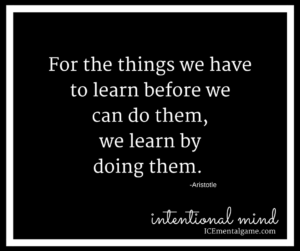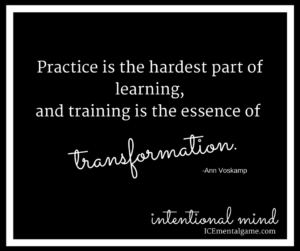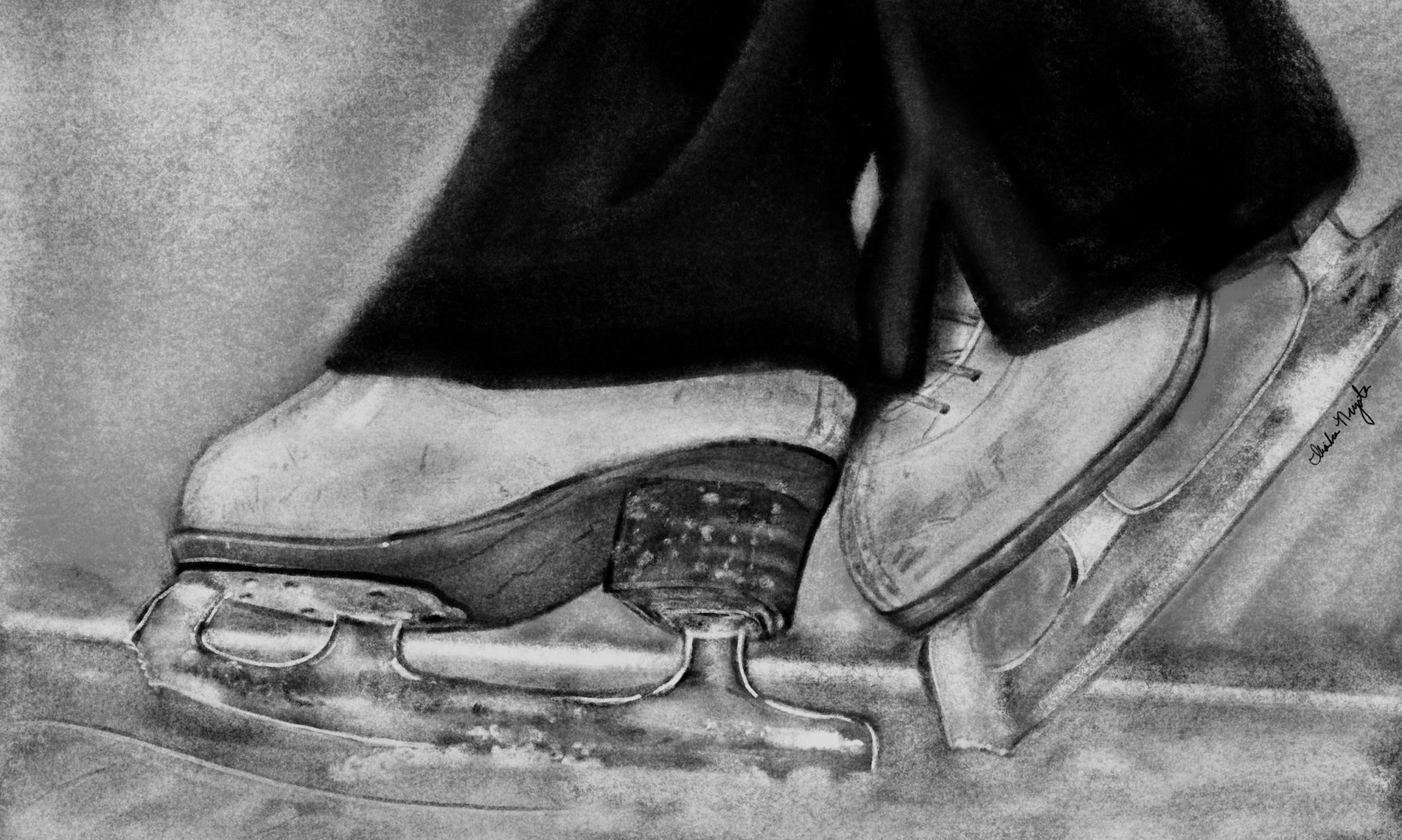 Do you have a plan for your daily on-ice practice time?
Do you have a plan for your daily on-ice practice time?
If you have a plan, is it an effective practice plan, one that will take you towards reaching your goal?
Here are some symptoms that you either don’t have your goal in mind or that your practice plan is not one that will focus your energies towards your goal:
Your coach often talks to you about not working hard enough, that they, “Don’t want to see you standing on the ice doing nothing, so get busy and work”.
You think, “I am working, I already did everything on my list, what do I do now?”
Or
You run your program over and over again during the session. In fact you run it so much that the kids on the ice all know your program by heart, and the parents are getting sick of hearing your song.
Or
Your parent complains that they don’t want to see you standing around at the boards, or that you look like you are aimlessly skating around the ice and, “Stop wasting ice time, if you don’t want to work, get off the ice, and let’s go home.”
Some skaters think that since the program is what they do in competition, it is the most important thing to practice. That is the case when you have mastered your elements and just need to put them into your program. However most skaters are still at the developmental level, and are constantly challenged by more difficult elements.
Research shows us that practicing in smaller pieces, (i.e. specific elements, like jumps, spins, edges or transitions) allows an athlete to improve much quicker. When you practice in smaller pieces, you can concentrate, and focus specifically on what you need to improve and you can do more repetitions of the skill.
When you “practice” by running your programs repeatedly, or when you look up to the stands every 5 minutes for direction from your parent, or when you have to stop and figure out what you are going to do next, you are not practicing in a way that will improve your skills as rapidly as is possible.
In most cases this is because you have never been taught how to make a practice plan that works.
Well meaning coaches sometimes forget that skaters need to be taught how to make and follow a training plan.
Your parents think that your coach has made a plan for you.
An important part of a strong mental game is taking action towards your goal. Just like learning an Axel, you can to learn how to design an effective practice plan for yourself.
Here are the steps to make a practice plan that works:
- Have a goal
- Know the steps that will take you from where you are to your goal
- Design a program that will allow you to be accountable for every minute you are on the ice
- Practice deliberately each and every day
- Keep mentally fresh by adjusting and challenging yourself with program maintenance
1) Have a goal:
Striving to reach a goal makes for a great practice session. When you are clear about the purpose of your practice, you will be able to focus more on improving. (For more on goal setting, read How to Absolutely Reach Your Goals.)
2) Know the steps that will take you from where you are to your goal:
When you know the skills you need to master before reaching your goal, you will be able to systematically take step after step towards reaching it.
For example: In order to learn your double Axel, you have to have consistent single Axel technique, and be able to rotate your double jumps. You need to know what you have to tweak in your technique to get the height and rotation for the double axel.
Your coach will teach you exercises or drills for improving the pieces needed for your double Axel, and if you pay attention, you can create a progression that you can use on the ice during practice.
If you are unsure of what you need to do, ask your coach to write it down for you or tell you what to do while you take notes.
3) Design a program that will allow you to be accountable for every minute you are on the ice
At ICE we teach our students how to create a “Modular Schedule” for their practice plan.
The dictionary definition of the word Module is: a separable component, frequently one that is interchangeable with others, for assembly into units of differing size, complexity, or function.
To explain how modules work, let’s use the example of a living room shelf unit, the type with little cubby holes, and baskets that fit in the holes.
The shelf is the framework, the structure you use to hold your modules. In skating this would be the time slots on your schedule.
Let’s use baskets to represent “modules.” The baskets are interchangeable and can be rearranged to live in any spot on the shelf unit.
The modules are the areas you need to work on skating. For example: Warm up, Edge work, Jumps, Program, Spins. With the exception of warm up, these sections can be placed in any order on the schedule.
Inside the baskets (modules) are items like towels, knick knacks, pens and pencils, toys. You can add or remove, switch them from one basket to the other depending on how you want to organize them.
In skating, this would be individual drills or exercises within the sections of your schedule. For example:
Module: Jumps
Drills or exercises: Back spin, landing position, double loop exercises
You decide how long your module will be.
For example: If you have an hour session, you might want to have 4-15 minute modules or 6-10 minute modules or 2-15 minute and 3-10 minute modules. If you are getting ready for a competition in altitude, you might want to devote more time to running programs.
The following are examples of the modules ICE has created with some of our students. Keep in mind that these are just examples, your modules will be different based on your skills and your coaches’ technique.![...spontaneity is possible only when everyone first engages in hours of highly repetitive and structured practice--perfecting their [skills], ...over and over again . . . spontaneity isn't random.](https://sportspsychologyskating.com/wp-content/uploads/spontaneity_practice-300x251.png)
Here is an example of a session, each item is a module:
Warm up
Edge work
Jumps
Program run-throughs
Spins
Cool Down
Here is an example of the drills or exercises in a 15 minute jump module:
Foot Warm Up exercises
Landing Position exercise
Waltz Jump
Backspin 5 reps
Backspin Double Loop exercise 5 reps
Axel exercises
Single Axel
Double Axel 3 reps
Toeloop exercises
Double Toeloop
Triple Toeloop
Triple Toeloop Combo 2 reps
Triple Loop Module
Loop Warm Up exercises
Double Loop
Loop Rotation exercise 2-3 reps
Walkthrough
Triple Loop
Repeat steps 3-6
Program Practice Module
Footwork
Warm up jumps
Warm up spins
Full Program run-through with music
1st half program segment (3 times) or 3 element programs
2nd half program segment (3 times)
Full or partial run-through for corrections
Using this type of “Modular Schedule” allows you to be more organized with less work.
You can:
- Build your practice session for the day or for the week in minutes and keep it updated easily.
- Adjust for times you are in lessons. If you have a lesson, you can delete a module, or shorten the list of exercises within each module to accommodate for the shorter session time.
- If your coach misses a lesson, you can add a module, or add exercises to a module so you aren’t skating around aimlessly.
- If you are focusing on program practice, with 6 minute warm up, you can move that module to the beginning of the day.
Modules make it easy for you to:
Replace the current exercises with more difficult or complex ones once you have learned them.
Remember what you need to  do because the information is organized in smaller, logical chunks. If you are working on jumps, it is easy to remember the sequence of exercises that progress you from the Sal to the Lutz, from singles to doubles or from doubles to triples. You don’t need to go to the boards very often to check your list.
do because the information is organized in smaller, logical chunks. If you are working on jumps, it is easy to remember the sequence of exercises that progress you from the Sal to the Lutz, from singles to doubles or from doubles to triples. You don’t need to go to the boards very often to check your list.
By using modules, you can create your schedule yourself or with the help of a coach or a parent. If you don’t know, your coach can also tell you the order for your modules during your session. If you don’t know where to start, ICE Mental Game can teach you how to organize and maintain your practice plan with our JumpStart program.
If you like using modules for on ice practice, make some for your off-ice practice too.
Once you set up your modular schedule, you will always know what to do during your practice session. You will get more work done in the same amount of time, and see more improvements for your effort.
4) Practice deliberately each and every day
Now you have a practice plan that leads you to your goal. The next step is to practice with a purpose.
Make sure you:
- Understand the purpose of each exercise or activity on your list.
- Do the exercise or drill with focus on the purpose.
- Include only the activities to improve your skills.
- Do enough repetitions to insure that your body learns the movement.
- Are doing the exercise correctly. Pay attention to corrections your coach gives you, so that you can tell what you are doing wrong and correct yourself when you practice the drill or exercise.
- Are mentally focused on improving your skills with a growing and learning mindset.
5) Keep mentally fresh by adjusting and challenging yourself with program maintenance
Check your plan every week, make changes and adjustments based on what you need to focus on for the week.
Make sure that the exercises you are doing are still taking you in the direction of your goal.
Make the exercises and skills more challenging as you improve.
Conclusion
Having an organized practice plan will boost your skill improvement because you are focused on very things that will take you to your target goal. Your physical skills improve quicker because your mind will be able to laser focus on improvement instead of deciding on what to do next.
In addition to more rapid improvement, your coach will be happy to see you working hard and your parents will be satisfied that you are making good use of your ice time.
The best part is that you will see more improvement in your skating skills.
If you want to learn more about how a strong mental game can take your skating to the next level, download our free Confidence eBook and take action towards a Champion Mindset.
